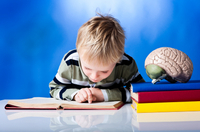All students have heard it before. The it is the constant nagging by parents and teachers about study habits.
Find a quiet place to study, study at the same time/same place every day, study in an empty room are some of the typical methods that parents or teachers preach.
However, they are wrong, absolutely wrong. A group of cognitive psychologists researched how to increase tangible learning through studying and discovered that most of the conventional wisdom about study habits is incorrect, according to an article in The New York Times.
The group of cognitive psychologists determined that alternating and mixing up studying is the key to effective studying. Students should alternate the rooms they study in rather than staying in the exact same room every day. This increases memory retention. Also, students should vary the material they study instead of focusing on a single subject.
“We have known these principles for some time, and it’s intriguing that schools don’t pick them up, or that people don’t learn them by trial and error,” said Robert A. Bjork, a psychologist at the University of California, Los Angeles. “Instead, we walk around with all sorts of unexamined beliefs about what works that are mistaken.”
The psychologists noted that these findings work for all ages. Also, a personal tutor could help students create and foster a positive studying environment.
Psychologists also examined the popular notion that students have personal learning styles. Conventional wisdom says that some students are visual learners while others are auditory learners. There are countless of other similar examples of how students learn differently. Recently, the journal Psychological Science in the Public Interest published a report stating that a group of psychologists found absolutely no support for this notion.
“The contrast between the enormous popularity of the learning-styles approach within education and the lack of credible evidence for its utility is, in our opinion, striking and disturbing,” the researchers concluded, according to The New York Times.
The New York Times cited a learning experiment from 1978. Psychologists placed college students in two separate rooms while they studied a list of 40 vocabulary words. The first room had no windows and was very cluttered; the other had a nice window view of the college’s courtyard. The students who studied with the window view did far better than the others.
Their conclusions were that the brain makes associations between what is being studied and the background sensations at the time. This forces the brain to make multiple associations with the same material, which increases neural activity. The brain then works harder and memory retention then increases.
The journal of Applied Cognitive Psychology recently published an online study in which two University of South Florida professors taught a group of fourth graders four equations that all calculate a different dimension of a prism. Half of the class was repeatedly taught one equation over and over again like the number of prism faces when given the number of sides at the base. These students then moved on to the next equation. The other half studied all four equations grouped together.
The fourth graders took a test the next day. Those who studied the problems together outscored those who did not 77 percent to 33 percent.
“When students see a list of problems, all of the same kind, they know the strategy to use before they even read the problem,” said Dr. Rohrer, one of the study’s creators. “That’s like riding a bike with training wheels.” With mixed practice, he added, “each problem is different from the last one, which means kids must learn how to choose the appropriate procedure — just like they had to do on the test.”

